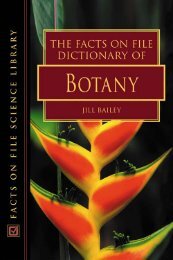You also want an ePaper? Increase the reach of your titles
YUMPU automatically turns print PDFs into web optimized ePapers that Google loves.
2.68<br />
2.67 Development of II sieve tube and its<br />
companion cells in a flowering plant. A,<br />
sic:ve: dement precursor cell; nOle its thin<br />
primary wall (1), large ,entrlll vacuole (2)<br />
and two nudei (3) with II de\"e!oping cell<br />
plate (4) between them. E, mature sieve<br />
clement and companion cells. The largest<br />
cdl formed from the precursor gives rise to<br />
the sieve: dement; which is enucleate: but<br />
Slill Terains its plasmalemma, modified<br />
plastids (5), miwchondri3, endoplasmic<br />
reticulum and proteinaceous fibrils (6).<br />
The end walls of the clement now form<br />
the sie\'c plates and are perforated by pores<br />
which are often apparendy occluded by<br />
fibrils. The cell wall is thickened at the sieve<br />
plale, and around the pores it comains<br />
amorphous callose. The [wo densely q'toplasmic,<br />
nucleated companion cells are<br />
formed after the funher division of the<br />
smaller derivative of the precursor cell<br />
shown in A. Companion cdl nucleus (7).<br />
I Primary wall<br />
2 Central \'acuole<br />
3 Nuclei<br />
4 Developing cell plate<br />
5 Plastid<br />
6 PrOteinaceous fibrils<br />
7 Companion cdl nuclei<br />
2.68 Sieve tube from the S[em of U,lum I/sitatissimum<br />
(flax}. Note the obliquely inclined sie\'e plate with whirish<br />
regions of callose surrounding rhe sieve pores (I). Several<br />
plastids (2) containing starch are visible in rhe sieve rube:<br />
and numerous fibrils of P.protein fill irs lumen. Companion<br />
cdl3. (G-Os, TE.\1 x 17,000.)<br />
I 1 Sieve pores<br />
2 Plasrids<br />
3 Companion cell<br />
,-------------------, 2.67<br />
A<br />
B<br />
• 'f--1<br />
rt--4<br />
2.69 TS of secondary phloem (formed from a seeondary<br />
thickening meristem) frOIll the stem of the monocotyledon,<br />
Dracaena. Note the oblique sieve pbtes wirh c:lllose (white<br />
:lreas) around the pores. Pbsrids (1) with st:ln.:h gmins :lre<br />
present in the lumina but P-protein is absent. (G-Os, TE\.l<br />
x 6,000.)<br />
Q P13_,_"_"' _<br />
55<br />
2.69





